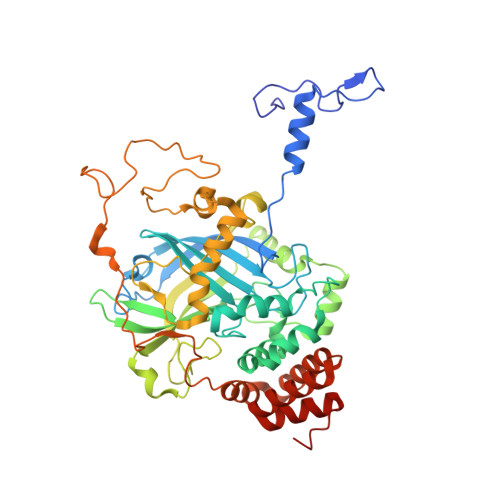Unprecedented access of phenolic substrates to the heme active site of a catalase: Substrate binding and peroxidase-like reactivity of Bacillus pumilus catalase monitored by X-ray crystallography and EPR spectroscopy.
Loewen, P.C., Villanueva, J., Switala, J., Donald, L.J., Ivancich, A.(2015) Proteins 83: 853-866
- PubMed: 25663126
- DOI: https://doi.org/10.1002/prot.24777
- Primary Citation of Related Structures:
4QOL, 4QOM, 4QON, 4QOO, 4QOP, 4QOQ, 4QOR - PubMed Abstract:
Heme-containing catalases and catalase-peroxidases catalyze the dismutation of hydrogen peroxide as their predominant catalytic activity, but in addition, individual enzymes support low levels of peroxidase and oxidase activities, produce superoxide, and activate isoniazid as an antitubercular drug. The recent report of a heme enzyme with catalase, peroxidase and penicillin oxidase activities in Bacillus pumilus and its categorization as an unusual catalase-peroxidase led us to investigate the enzyme for comparison with other catalase-peroxidases, catalases, and peroxidases. Characterization revealed a typical homotetrameric catalase with one pentacoordinated heme b per subunit (Tyr340 being the axial ligand), albeit in two orientations, and a very fast catalatic turnover rate (kcat = 339,000 s(-1) ). In addition, the enzyme supported a much slower (kcat = 20 s(-1) ) peroxidatic activity utilizing substrates as diverse as ABTS and polyphenols, but no oxidase activity. Two binding sites, one in the main access channel and the other on the protein surface, accommodating pyrogallol, catechol, resorcinol, guaiacol, hydroquinone, and 2-chlorophenol were identified in crystal structures at 1.65-1.95 Å. A third site, in the heme distal side, accommodating only pyrogallol and catechol, interacting with the heme iron and the catalytic His and Arg residues, was also identified. This site was confirmed in solution by EPR spectroscopy characterization, which also showed that the phenolic oxygen was not directly coordinated to the heme iron (no low-spin conversion of the Fe(III) high-spin EPR signal upon substrate binding). This is the first demonstration of phenolic substrates directly accessing the heme distal side of a catalase.
- Department of Microbiology, University of Manitoba, Winnipeg, Manitoba, R3T 2N2, Canada.
Organizational Affiliation:




















